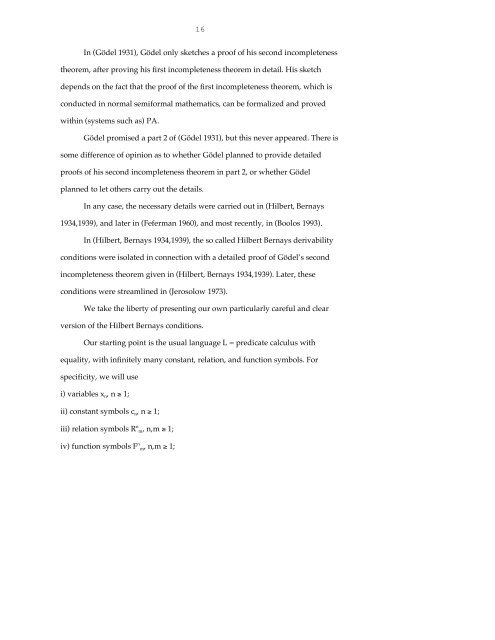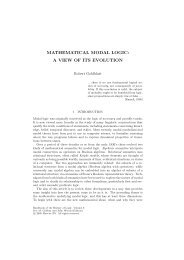my forty years on his shoulders - Department of Mathematics
my forty years on his shoulders - Department of Mathematics
my forty years on his shoulders - Department of Mathematics
- No tags were found...
Create successful ePaper yourself
Turn your PDF publications into a flip-book with our unique Google optimized e-Paper software.
16In (Gödel 1931), Gödel <strong>on</strong>ly sketches a pro<strong>of</strong> <strong>of</strong> <strong>his</strong> sec<strong>on</strong>d incompletenesstheorem, after proving <strong>his</strong> first incompleteness theorem in detail. His sketchdepends <strong>on</strong> the fact that the pro<strong>of</strong> <strong>of</strong> the first incompleteness theorem, which isc<strong>on</strong>ducted in normal semiformal mathematics, can be formalized and provedwithin (systems such as) PA.Gödel promised a part 2 <strong>of</strong> (Gödel 1931), but t<strong>his</strong> never appeared. There issome difference <strong>of</strong> opini<strong>on</strong> as to whether Gödel planned to provide detailedpro<strong>of</strong>s <strong>of</strong> <strong>his</strong> sec<strong>on</strong>d incompleteness theorem in part 2, or whether Gödelplanned to let others carry out the details.In any case, the necessary details were carried out in (Hilbert, Bernays1934,1939), and later in (Feferman 1960), and most recently, in (Boolos 1993).In (Hilbert, Bernays 1934,1939), the so called Hilbert Bernays derivabilityc<strong>on</strong>diti<strong>on</strong>s were isolated in c<strong>on</strong>necti<strong>on</strong> with a detailed pro<strong>of</strong> <strong>of</strong> Gödel’s sec<strong>on</strong>dincompleteness theorem given in (Hilbert, Bernays 1934,1939). Later, thesec<strong>on</strong>diti<strong>on</strong>s were streamlined in (Jerosolow 1973).We take the liberty <strong>of</strong> presenting our own particularly careful and clearversi<strong>on</strong> <strong>of</strong> the Hilbert Bernays c<strong>on</strong>diti<strong>on</strong>s.Our starting point is the usual language L = predicate calculus withequality, with infinitely many c<strong>on</strong>stant, relati<strong>on</strong>, and functi<strong>on</strong> symbols. Forspecificity, we will usei) variables x n , n ≥ 1;ii) c<strong>on</strong>stant symbols c n , n ≥ 1;iii) relati<strong>on</strong> symbols R n m, n,m ≥ 1;iv) functi<strong>on</strong> symbols F n m, n,m ≥ 1;
















